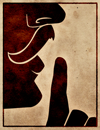The Avid Horizon

|
WARNING: Beyond this point lie spoilers for Fallen London's most infamous storyline: Seeking Mr Eaten's Name. Turn back now. You can find out more about our spoiler policy here. |
"Two vast winged shapes guard a gate of something like resin, smooth but uneven. It is deep gant - the colour that remains when all other colours have been eaten. Ice crusts over the crack between its valves. Approach, and your breath freezes, falls tinkling in shards from the air. It would be utterly foolish to touch the thing"[1]
The Avid Horizon is the gate that links the Unterzee to the High Wilderness.
The Neath
"The unterzee has no northern shore. Space is forbidden. Time contracts to a single frozen instant. There is only one way North."[2]
The Avid Horizon is the northernmost known place in the Unterzee - as in, travel North far enough, from anywhere in the Zee, and you'll find yourself gawking at its guardian statues. It's bitter cold, and by 1900, nobody's gone further. Dozens have died trying. Zailors, of course, are advised not to go.[3][4]
One of the nearby docks offers those who have been exiled from London a chance to beg for forgiveness, but they must be willing to sacrifice everything, and there is no guarantee the Admiralty will choose to accept their apology.[5]
The realm of the Judgements, the High Wilderness, lies beyond the freezing High Gate. However, opening it is easier said than done: a truly courageous explorer must distract the eternally vigilant Watchers to unlatch it.[6][7]
We kindly request that no one reveal what happens beyond THE KING OF WAYS in the end of Seeking Mr Eaten's Name.
-Mr Feathers
The High Wilderness
"Bordered by two vast winged statues, the Gate towers over the shrouded sea that divides the port and the Gate. The other side of the gate opens far beneath the Earth, on the bleak shore of a subterranean sea."[8]
The Avid Horizon served as the Empire's gateway into the heavens; it was here that the Parzifal,[9] the first spacefaring locomotive (or so they say), was built and launched.[10] After New London was built and the vast majority of the city had reestablished itself in the skies, the Empress sealed the gates to the Horizon "sarcophagus-tight;" there was a long enough span of time before this happened, however, that a sea formed in space.[11]
The Horizon is made of three parts: the Home Office, a vestigial and bare-bones immigration facility; the Gate, under the eternal eyes of the Watchers; and the Quiet Sea, an inexplicable spillage of the nostalgic Unterzee.[12]
It is worth noting that the Horizon is a lot bigger on the space side, and it's rather far from New London. It's quite a feat of engineering that they got all the pieces of London so far away from the gate to the Wilderness.
Like its counterpart in the Neath, the Empire uses the Horizon to get rid of people who anger its royalty, this time by forcing them to wait in front of the rather imposing gate for a pardon that will almost never come.[13] The Gate also has a mooring post nearby that's covered in crimes, confessions, and names, as an imitation of the tradition before the Wilderness was conquered - though it's not London that answers these pleas anymore, but a criminal organization called the Gentlemen.[14]
The Cults of the Quiet Sea
- The Supralapsarians, led by The Illuminated Archivist, who long for the time of Old London and try to pretend that they have never left.[15][16]
- The Sanctified, led by the Jolly Anchorite, a wine-loving bunch who venerate the Masters of the Bazaar as saints - especially Mr Wines.[17][18]
- The Displeased, led by The Careful Masquerader, who feel betrayed by those around them, and so they shall betray as well.[19]

|
Beyond this point lie major spoilers for Fallen London, Sunless Sea, Sunless Skies, or Mask of the Rose. This may include endgame or major Fate-locked spoilers. Proceed at your own risk. You can find out more about our spoiler policy here. |
The Gate of Saints
The Watchers at the gate are not simple statues; they were in fact former servants of the King of Hours, before the monarch's death.[20] The statues, also known as the Saint of the Key and the Saint of the Lock, were built by and in the image of the Masters, to guard the way behind them - all under the indulgence of the King of Hours.[21]